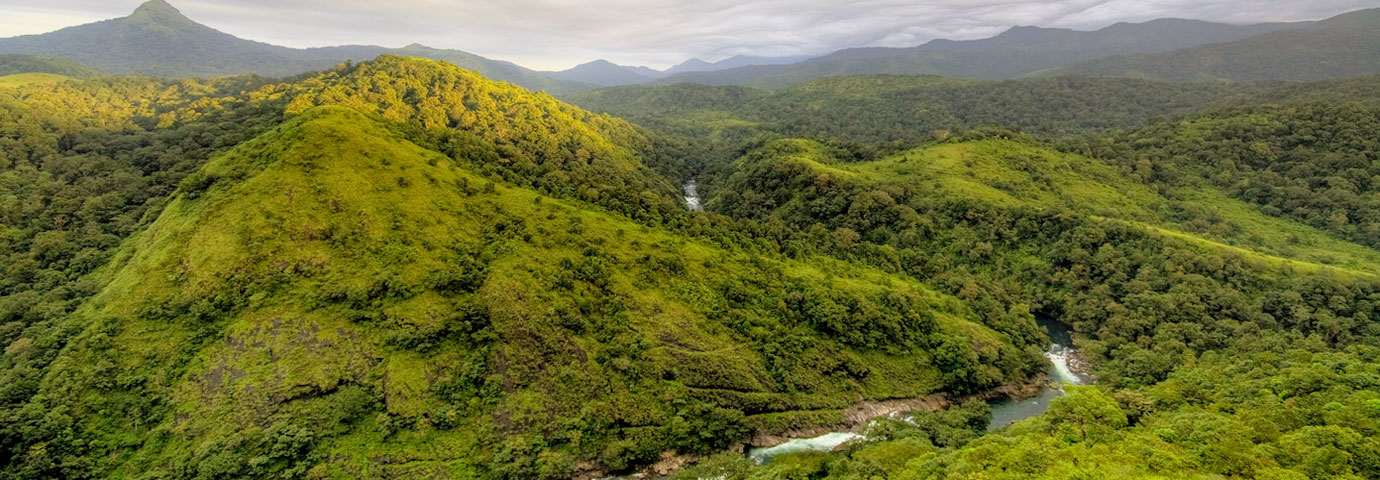Fast Facts
|
Area
|
89 sq km
|
|
Altitude
|
658 - 2,383 metre above sea level
|
|
Maximum Temperature |
39°C |
|
Minimum Temperature |
20.4°C |
|
Language |
Malayalam, English |
|
Best time to visit |
September to March |
Located in the Kundali Hills of the Western Ghats, the Silent Valley National Park holds a valuable reserve of rare plants and herbs. The park is rich in its wildlife, and elephants, lion-tailed macaques and tigers are the most common denizens of this park. A visit to this park should be considered a lifetime experience, as this is the last representative virgin tract of tropical evergreen forests in India.
Though smaller in size in comparison to the other national parks in India, what makes it unique is the sylvan environment the region has along with its high altitude peaks and several rivers that run through it.
History Of Silent Valley
Silent Valley has a very eventful history in comparison to the other wildlife parks in the country. The local name for the park is Sairandhrivanam (the forest in the valley) and had been a centre of hot debates and protests in the decades of the 70's and 80's of the 20th century. The history of the park goes way back to 1888 when the region was declared a reserved land under the Forest Act and later notified as a Reserved Forest by the Government of Madras in 1914.
In the later half of the 1970's, Kerala State Electricity Board decided to construct a Hydel Power Project in this region and when in 1980, this region was declared as National Park, the area of Hydel Project was not included. This started fierce discussions and protests and the Board had to drop its plan. Subsequently, in 1984, the park was again renotified as a National Park with the project area included. In 1986, the Silent Valley was declared the core area in the Nilgiri Biosphere Reserve.
Location Of Silent Valley
The Silent Valley National Park is situated in the Palghat or Palakkad district of the southern Indian state of Kerala. A part of the Western Ghat along the Arabian Sea, the park extends from latitude 11°04' in the North to longitude 76°79' in the East. The park is contiguous with Attappadi Reserve Forests in the east, and vested forests of the Palghat and Nilambur divisions in the west and south. In the North, the park is an extension of the Nilgiri Forests.
Best Time To Visit Silent Valley
The Silent Valley National Park is a heavy rainfall region with the places in the higher altitudes getting the highest rain. The average rainfall in the region varies between 2800 and 3400 mm. The park receives most of its rainfall during the southwest monsoon from June to December. The relative humidity is considerably high during this season with the maximum at times going to 95%. April and May are the hottest months while January and February are the coolest months, though not much difference in the temperature is experienced.
Tourists Attractions In Silent Valley
Flora In Silent Valley
The vegetation of this park is tropical moist evergreen forest with the special status of Rain Forests. The main plants are teak, semal, amla, rosewood, and bamboo.
On the basis of altitude, one can divide the vegetation types in four different categories. The tropical evergreen forests comprise extensive dense forests along the hills and valleys. The sub tropical hill forests take the areas of higher altitude while the temperate forests are characterized by the unrelated evergreen species with a dense closed canopy. The grasslands are mainly limited to the higher slopes and hilltops in the eastern sector.
Fauna In Silent Valley- The park has a strong fauna population with many of the endangered species residing here. Most commonly seen here are elephant, tiger, lion-tailed macaque, gaur, wild pig, panther and sambar. Some other species of wildlife have also been recorded here including 15 species of invertebrates, two fishes, and two amphibians.
The park has a total of 26 species of mammals and 120 species of avifauna, many of them considered endangered. Apart from these, there are 11 species of snakes, 19 species of amphibians, and nine species of lizards in the park.
Places Around Silent Valley National Park
In the vicinity of the Silent Valley National Park are situated wildlife sanctuaries such as the Parambikulam, Choolanur Peacock Sanctuary, Attappadi or Mountain Valley in Agasthyakoodam, and JP Smriti Vanam. Also in the vicinity are hill stations like Coonoor and commercial centers like Coimbatore.
How To Reach Silent Valley
By Air - Peelamamedu Airport, Coimbatore (155 km from the Silent Valley National Park). Coimbatore is the nearest airport and there are regular flights to Chennai, Kozhikode, Mumbai, and Madurai of the Indian Airlines and Jet Airways.
By Rail - Olavakkode Railway Station, Palghat (75 km from the Silent Valley National Park). The nearest railway station is Palghat connected to all the metros and most of the other important cities of the country by regular trains.
By Road - Mannarghat (32 km from the Silent Valley National Park). Mannarghat is the nearest important township from where one can get buses to all the places in the region like Palghat, Coimbatore and others. There are frequent buses from Palghat to the Silent Valley National Park. Buses are also available from Coimbatore to the park.


